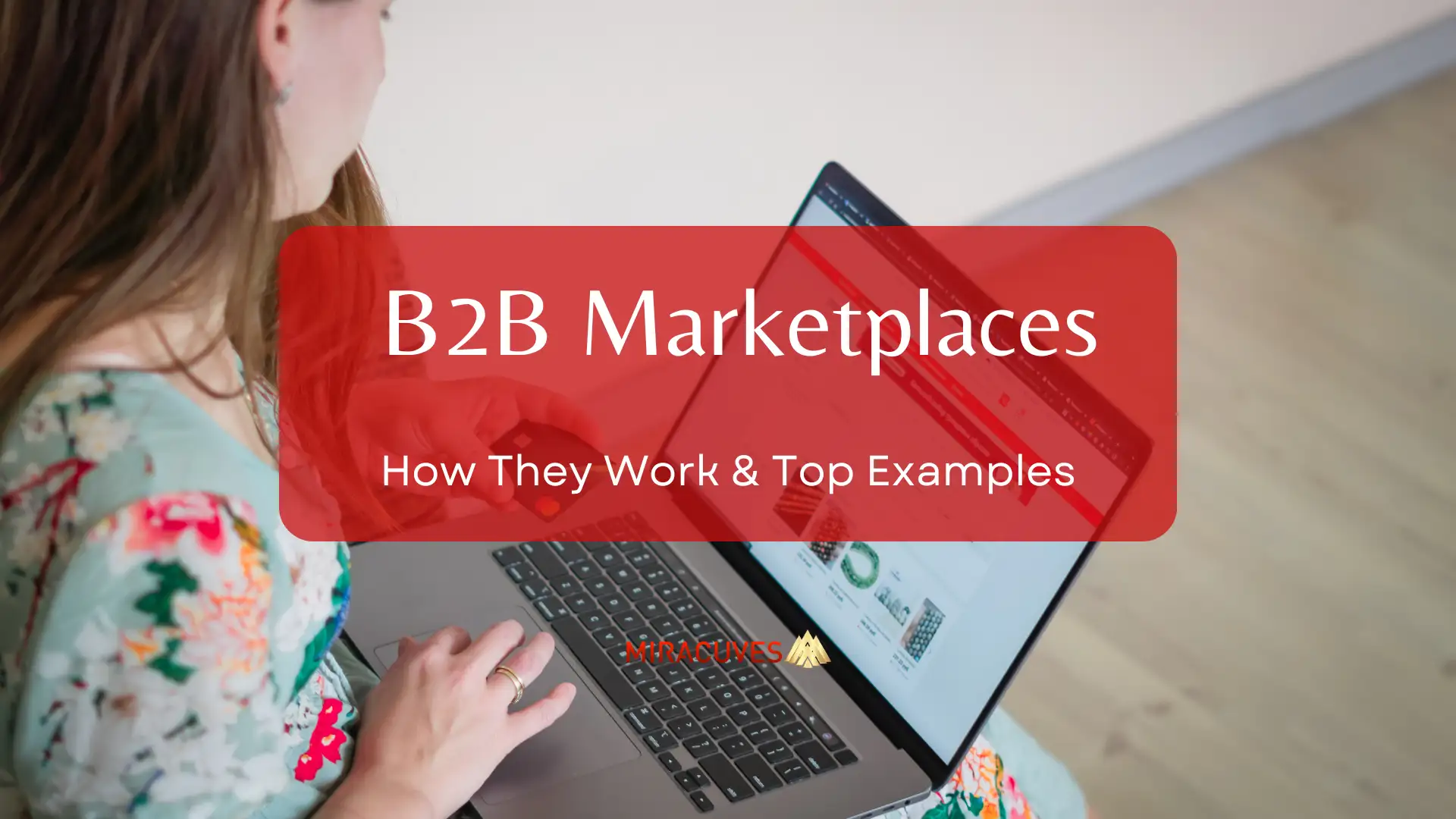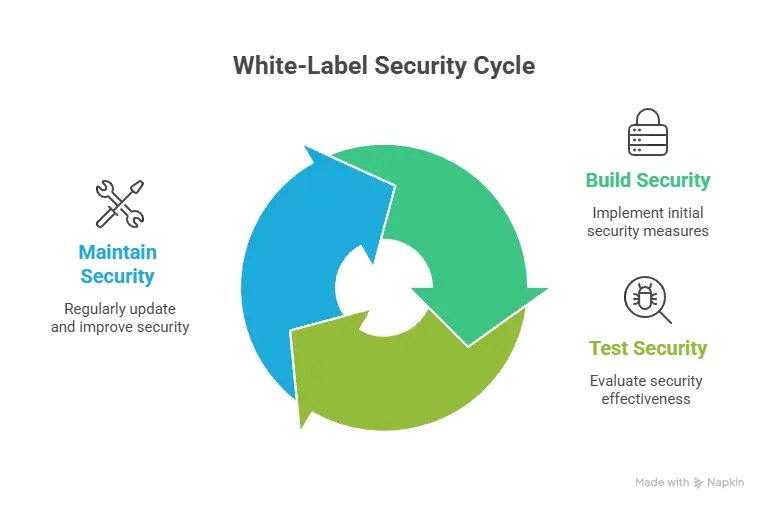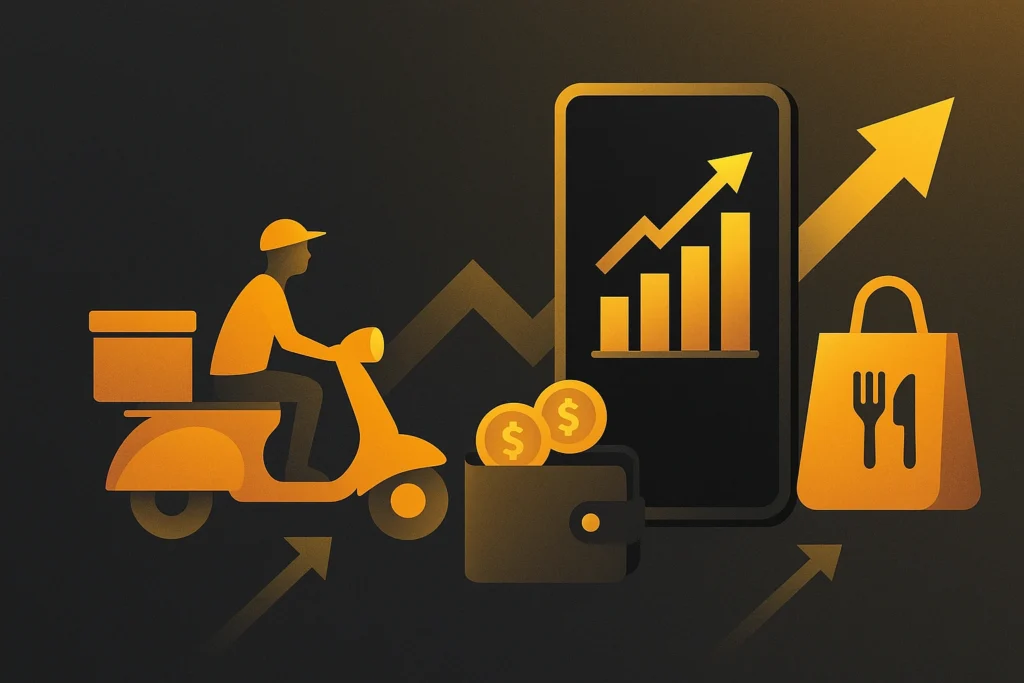In the rapidly evolving digital economy, B2B marketplaces have become essential hubs that facilitate business-to-business transactions across diverse industries. These platforms enable companies to efficiently buy, sell, and trade products and services on a global scale, offering immense opportunities for growth and expansion. As businesses increasingly prioritize digital transformation, B2B marketplaces are gaining traction, providing seamless experiences, transparency, and cost efficiency.
With technology evolving, these platforms have transformed beyond simple listing sites into sophisticated ecosystems integrating logistics, payment solutions, and AI-driven analytics. This shift allows businesses to make data-informed decisions, streamline procurement processes, and optimize their supply chains. Companies of all sizes now find it easier to access a global network of suppliers and buyers, making the B2B business model not just viable but a strategic advantage in today’s marketplace.
The importance of B2B technology is evident in the surge of digital marketplace platforms like Alibaba, Amazon Business, and Global Sources. These platforms offer varied business models—from subscription-based services to commission structures—allowing businesses flexibility and control over their growth. The expansion of the platform economy means businesses must understand how these marketplaces work and choose the right platform tailored to their needs.
In this guide, we will explore how B2B marketplaces function, their benefits, the types available, and how to leverage them effectively. By understanding the dynamics of these platforms, businesses can position themselves to thrive in 2024 and beyond.
What Are B2B Marketplaces?
B2B marketplaces are digital platforms where businesses interact to buy and sell products or services directly with other businesses. Unlike B2C models, which focus on direct sales to consumers, B2B marketplaces facilitate transactions between companies, enabling bulk purchases, contract negotiations, and long-term partnerships. These platforms create an ecosystem where manufacturers, wholesalers, suppliers, and retailers collaborate seamlessly.
At their core, B2B marketplaces operate as intermediaries, providing the infrastructure for businesses to manage complex transactions efficiently. By integrating payment gateways, logistics support, and customer service tools, these platforms not only simplify procurement but also enhance trust and reliability between parties. Examples of B2B marketplaces include industry giants like Alibaba, which connects global suppliers with businesses, and ThomasNet, which serves industrial and manufacturing sectors.
These marketplaces offer various business models to suit different needs:
- Commission-Based Model: Platforms take a percentage of each transaction.
- Subscription-Based Model: Businesses pay a recurring fee for platform access and features.
- Hybrid Model: Combines elements of both commission and subscription, offering flexibility for businesses.
As businesses increasingly seek efficient, transparent, and scalable solutions, B2B marketplaces are evolving to meet these demands. They are no longer just static directories but dynamic platforms powered by AI, data analytics, and blockchain, ensuring a secure, efficient, and scalable experience for business transactions.
How B2B Marketplaces Work
B2B marketplaces function as comprehensive platforms that connect businesses—buyers and suppliers—through digital ecosystems designed for seamless transactions. These platforms have several key components that facilitate efficient and transparent operations:
- Suppliers and Buyers: Suppliers list their products or services, while buyers browse the catalog to find suitable options. The platform acts as a bridge, ensuring both parties interact securely and efficiently.
- Platform Infrastructure: B2B marketplaces are powered by robust technology frameworks that integrate:
- Catalog Management: Suppliers upload and manage their product listings.
- Search and Filter Functions: Buyers use advanced search features to find products based on categories, pricing, availability, and other specifications.
- Transaction and Payment Gateways: Secure payment systems allow businesses to process transactions using multiple payment methods, such as bank transfers, digital wallets, or credit terms.
- Logistics Integration: Many B2B marketplaces provide integrated logistics solutions, streamlining the shipping and delivery process. This is crucial, as B2B transactions often involve bulk orders and international shipping, which require efficient and reliable logistics management.
- Analytics and Data: B2B marketplaces utilize AI and data analytics to track buyer behavior, optimize search results, and provide insights to suppliers on demand trends. This helps businesses make informed decisions, refine strategies, and increase sales.
- Business Models: B2B marketplaces typically operate using one of these business models:
- Commission-Based: The platform charges a fee per transaction.
- Subscription-Based: Businesses pay a recurring fee for access to features like analytics, premium placement, and marketing tools.
- Freemium or Hybrid: A combination where basic services are free, but advanced tools and features are paid.
B2B marketplaces streamline complex business transactions by providing a comprehensive digital ecosystem that covers everything from listing products to managing payments and logistics. This integrated approach reduces friction, enhances transparency, and builds trust between businesses, making the procurement process faster, easier, and more efficient.
Market Size and Statistics
The global B2B marketplace sector has witnessed substantial growth in recent years, driven by increased digitalization and the shift towards e-commerce solutions. In 2024, the B2B e-commerce market is expected to surpass $20 trillion, reflecting the growing importance of digital platforms for businesses. This surge is attributed to technological advancements, such as AI, big data, and blockchain, which enhance the efficiency and security of transactions.
| Year | Market Size (USD Trillions) | Growth Rate (CAGR) |
|---|---|---|
| 2022 | $15 Trillion | 10% |
| 2023 | $18 Trillion | 12% |
| 2024 | $20 Trillion | 15% |
| 2030 (Projected) | $30 Trillion | 15% |
B2B marketplaces like Alibaba and Amazon Business dominate the landscape, providing access to millions of products and a global supplier network. These platforms empower businesses to scale quickly, optimize their supply chains, and access international markets without the need for complex infrastructure.
According to industry analysts, B2B marketplaces are projected to grow at a compound annual growth rate (CAGR) of over 15% through 2030. This growth indicates a continued shift from traditional procurement methods to digital solutions. Businesses that adapt early to these platforms can leverage new revenue streams, reduce costs, and streamline their operations.
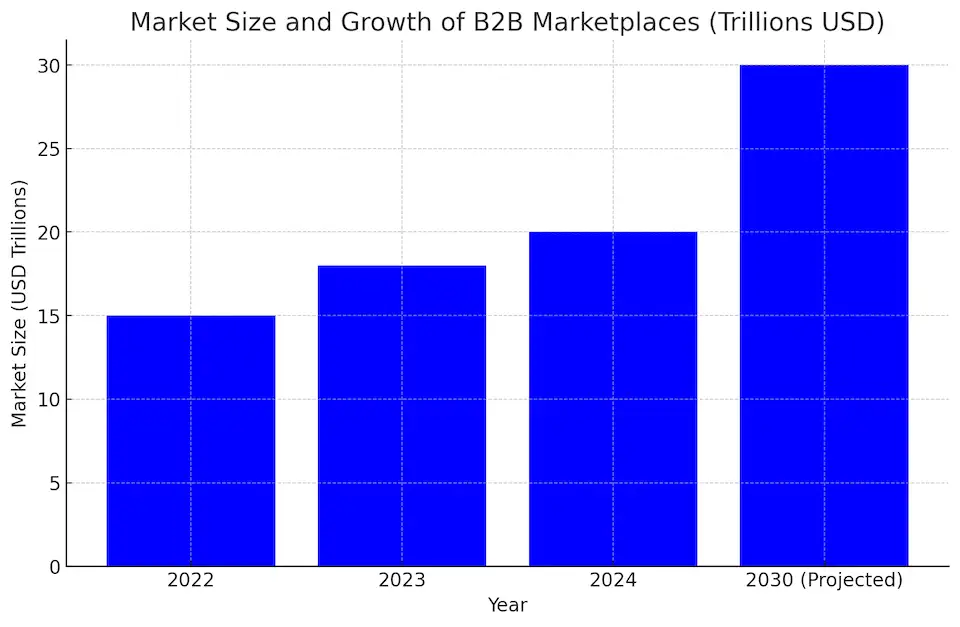
Understanding these market trends and growth statistics is vital for businesses aiming to capitalize on the opportunities offered by digital B2B platforms in 2024 and beyond.
Benefits of Using B2B Marketplaces
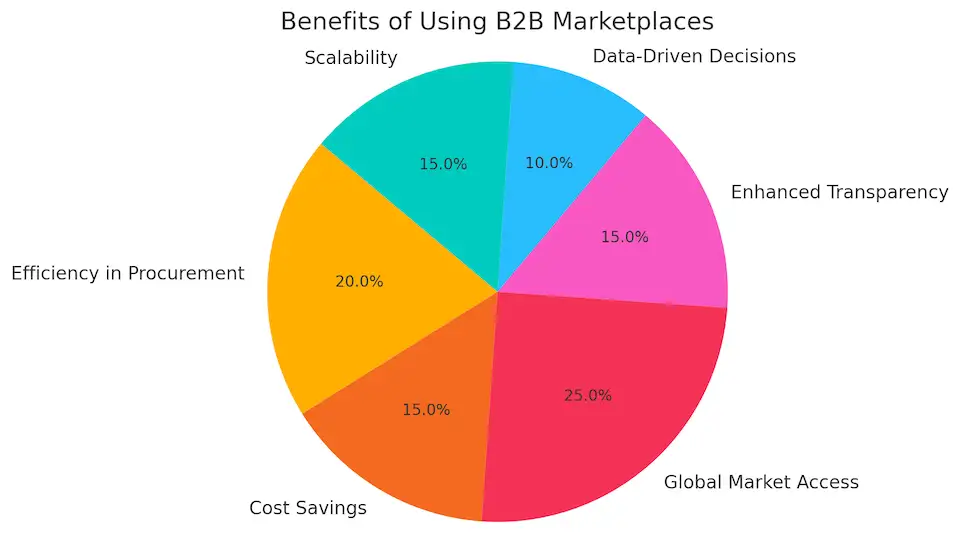
B2B marketplaces offer a range of benefits that make them indispensable tools for modern businesses:
- Efficiency in Procurement:
- B2B marketplaces streamline the procurement process, enabling businesses to search, compare, and purchase products or services quickly. Automated processes reduce manual paperwork and errors, saving time and resources.
- Cost Savings:
- Businesses can access multiple suppliers and compare prices in real time, ensuring they receive competitive rates. The ability to negotiate bulk orders and long-term contracts further enhances cost efficiency.
- Global Market Access:
- These platforms provide businesses with instant access to international suppliers, expanding their reach and increasing the potential for new partnerships. This global connectivity helps companies diversify their supply chains and reduce risks.
- Enhanced Transparency:
- B2B marketplaces offer transparent information about product availability, pricing, and supplier ratings. This transparency builds trust and confidence, leading to long-term relationships between buyers and suppliers.
- Data-Driven Decisions:
- Advanced analytics tools integrated into these platforms help businesses track purchase history, monitor supplier performance, and analyze market trends. This data enables companies to make informed, strategic decisions that align with their goals.
- Scalability:
- B2B marketplaces are designed to scale with a business’s growth, providing infrastructure that accommodates increased transaction volumes, diverse product ranges, and expanding customer bases.
- Secure Transactions:
- Platforms employ robust payment gateways and security protocols to protect sensitive business information and ensure safe transactions, reducing the risks associated with traditional procurement methods.
| Benefit | Description |
|---|---|
| Efficiency in Procurement | Streamlined processes, reduced paperwork, faster transactions |
| Cost Savings | Access to competitive pricing and bulk discounts |
| Global Market Access | Connects businesses with international suppliers and buyers |
| Enhanced Transparency | Provides data on pricing, supplier ratings, and product availability |
| Data-Driven Decisions | Offers analytics tools for strategic business insights |
| Scalability | Platforms grow with the business’s needs |
By leveraging these benefits, businesses can optimize their operations, reduce costs, and create more efficient and reliable supply chains, positioning themselves for growth in the competitive B2B market landscape.
Challenges Faced by B2B Marketplaces
While B2B marketplaces offer numerous benefits, they also come with specific challenges:
- Trust and Security Concerns:
- Establishing trust between businesses, especially in cross-border transactions, can be difficult. Concerns about data security, fraud, and payment issues are significant barriers for many companies.
- Scalability Issues:
- As businesses grow, scaling their operations on a B2B platform can be challenging. Ensuring that the platform can handle increased traffic, larger transactions, and more complex logistics requires robust infrastructure and technology.
- Compliance and Legal Regulations:
- B2B marketplaces must navigate a web of local and international regulations, including tax compliance, product standards, and trade restrictions. Adapting to these regulations is critical but can be a complex process for global platforms.
- Integration Complexities:
- Integrating a B2B marketplace platform with existing enterprise resource planning (ERP) systems, customer relationship management (CRM) software, and other internal tools can be technically challenging. Without proper integration, businesses may face operational inefficiencies.
- Supplier and Product Verification:
- Ensuring the authenticity of suppliers and the quality of products is vital to maintaining a trustworthy marketplace. Verification processes can be resource-intensive but are necessary to mitigate risks.
Modern B2B platforms are increasingly using technologies like blockchain for transparency, AI for fraud detection, and APIs for seamless integration to overcome these challenges, ensuring more secure and efficient operations.
Types of B2B Marketplaces
B2B marketplaces can be categorized based on their focus and the services they offer. Understanding these types helps businesses choose the right platform for their needs:
- Vertical Marketplaces:
- These focus on a specific industry or niche, such as construction, healthcare, or agriculture. Examples include ThomasNet, which caters to the industrial sector, and Medline, a platform for medical supplies.
- Advantages: Tailored solutions, industry-specific products, and specialized support.
- Horizontal Marketplaces:
- Unlike vertical platforms, horizontal marketplaces cover multiple industries, offering a wide range of products and services. Alibaba and Amazon Business are prominent examples, connecting diverse suppliers with buyers across various sectors.
- Advantages: Broad product range, scalability, and extensive global reach.
- Managed Marketplaces:
- These platforms go beyond connecting buyers and suppliers by offering value-added services like logistics, quality control, and customer support. An example is Faire, which provides support for wholesale buyers and suppliers, including logistics management and product verification.
- Advantages: Enhanced control over the transaction process and improved trust and quality assurance.
- Hybrid Marketplaces:
- Combining elements of vertical, horizontal, and managed marketplaces, hybrid platforms offer flexibility to businesses by providing both broad and industry-specific products along with additional services like analytics and support.
By understanding these types, businesses can better identify which marketplace aligns with their needs, industry focus, and growth strategies, ensuring they choose a platform that optimally supports their operations and scalability goals.
B2B Marketplace vs. Traditional Procurement
As businesses navigate the digital landscape, the shift from traditional procurement methods to B2B marketplaces has become increasingly prominent. Understanding the differences between these two approaches is crucial for companies looking to optimize their supply chains and procurement processes. Below is a detailed comparison of B2B marketplaces and traditional procurement.
1. Efficiency and Speed
- B2B Marketplaces:
- Offer streamlined, automated processes for finding, negotiating, and purchasing products or services.
- Features like real-time product availability, instant payment processing, and logistics integration significantly reduce the time needed for procurement.
- Automation of repetitive tasks (e.g., invoice generation, order tracking) increases efficiency, allowing businesses to focus on strategic activities.
- Traditional Procurement:
- Often involves manual processes such as contacting suppliers individually, negotiating contracts, and handling paperwork.
- The time-consuming nature of traditional methods can result in delays, slower decision-making, and increased operational costs.
- Coordination with multiple suppliers and managing different contract terms without a unified system can create inefficiencies.
2. Cost Implications
- B2B Marketplaces:
- Provide transparent pricing, enabling businesses to compare rates and negotiate better deals easily.
- Discounts for bulk purchases and subscription-based services can lead to significant cost savings.
- By minimizing manual work, businesses also reduce administrative costs associated with traditional procurement methods.
- Traditional Procurement:
- Involves higher operational costs due to the manual nature of supplier management, contract handling, and payment processing.
- Limited access to competitive pricing or bulk discounts, particularly if the company is restricted to local or regional suppliers.
- Requires additional investment in manpower and resources to manage procurement operations effectively.
3. Global Access and Supplier Network
- B2B Marketplaces:
- Offer access to a global network of suppliers, allowing businesses to source products or services from multiple regions.
- Platforms like Alibaba and Amazon Business connect buyers with international sellers, expanding options beyond local markets.
- This global reach enables businesses to diversify their supply chains, reducing dependency on single suppliers and mitigating risks.
- Traditional Procurement:
- Typically limited to local or existing networks of suppliers, restricting the scope of options and potential for diversification.
- Establishing new supplier relationships outside the region can be challenging and time-consuming, often involving complex negotiations and logistics.
4. Transparency and Data Insights
- B2B Marketplaces:
- Platforms provide real-time data on product availability, pricing, and supplier performance, promoting transparency throughout the procurement process.
- Analytics tools integrated into B2B marketplaces track transaction history, buyer behavior, and market trends, offering businesses valuable insights to optimize their strategies.
- Enhanced transparency builds trust between buyers and sellers, improving the overall marketplace experience.
- Traditional Procurement:
- Often lacks transparency, as businesses may need to rely on suppliers for information regarding availability, pricing, and delivery times.
- Limited access to real-time data and analytics makes it difficult for businesses to make informed decisions quickly.
- The manual nature of traditional procurement means less visibility into overall spend patterns, supply chain performance, and potential opportunities for improvement.
5. Flexibility and Scalability
- B2B Marketplaces:
- Designed to scale with a business’s growth, offering flexibility in managing larger volumes, integrating new suppliers, and expanding product catalogs.
- Automated processes and API integrations facilitate seamless expansion without the need for significant infrastructure changes or additional resources.
- Features like flexible payment terms, multiple logistics options, and comprehensive support make these platforms adaptable to changing business needs.
- Traditional Procurement:
- Scaling traditional methods can be complex and resource-intensive, requiring increased manpower and infrastructure adjustments.
- Limited flexibility when it comes to handling large order volumes or managing diverse supplier relationships simultaneously.
- Expansion often necessitates building new networks and implementing additional processes, which can be time-consuming and costly.
Summary Comparison Table
| Aspect | B2B Marketplaces | Traditional Procurement |
|---|---|---|
| Efficiency | Automated, real-time processes | Manual, time-consuming steps |
| Cost | Transparent pricing, cost-saving options | Higher operational costs, limited discounts |
| Global Access | Access to international suppliers and markets | Restricted to local or known networks |
| Transparency | Real-time data, analytics insights | Limited visibility and data access |
| Scalability | Easily scalable and flexible for business growth | Complex and resource-intensive to scale |
The transition from traditional procurement to B2B marketplaces offers businesses significant advantages in terms of efficiency, cost savings, and scalability. While traditional methods may still be relevant for certain industries and businesses, the flexibility, transparency, and global reach of digital platforms make B2B marketplaces the preferred choice for modern businesses aiming to thrive in a competitive and evolving market landscape.
Accelerate your marketplace’s success!
Get hands-on experience with our proven marketplace models
and tools designed to boost revenue and engagement.
Key Technologies Powering B2B Marketplaces
B2B marketplaces are more than just digital platforms for buying and selling products; they are sophisticated ecosystems powered by advanced technologies that enhance efficiency, security, and user experience. These technologies ensure seamless transactions, data-driven insights, and scalability, making B2B marketplaces indispensable for modern businesses. Here’s a detailed look at the key technologies driving these platforms:
- Artificial Intelligence (AI) and Machine Learning (ML):
- AI and ML algorithms play a pivotal role in optimizing the functionality of B2B marketplaces. These technologies are used for:
- Personalized Recommendations: AI analyzes buyer behavior, purchase history, and preferences to suggest relevant products, improving conversion rates and user satisfaction.
- Dynamic Pricing: ML models adjust prices based on demand, competition, and inventory levels, helping businesses remain competitive while maximizing profits.
- Chatbots and Virtual Assistants: AI-powered chatbots offer 24/7 customer support, handling inquiries, assisting with orders, and providing product information.
- AI and ML algorithms play a pivotal role in optimizing the functionality of B2B marketplaces. These technologies are used for:
- Blockchain Technology:
- Blockchain is revolutionizing B2B marketplaces by providing secure, transparent, and tamper-proof transaction records. It is particularly valuable for:
- Smart Contracts: Automating transactions based on predefined conditions, reducing delays, and eliminating the need for intermediaries.
- Enhanced Security: Blockchain ensures the integrity and security of sensitive data, minimizing the risks of fraud or manipulation.
- Traceability: Businesses can track the movement of goods and verify their origin, enhancing transparency and compliance with regulatory standards.
- Blockchain is revolutionizing B2B marketplaces by providing secure, transparent, and tamper-proof transaction records. It is particularly valuable for:
- Cloud Computing:
- Cloud infrastructure is fundamental for B2B marketplaces, offering scalability and flexibility. Cloud services enable:
- Scalable Operations: Platforms can scale resources up or down based on traffic and transaction volumes, ensuring consistent performance even during peak periods.
- Data Storage and Processing: Cloud solutions provide robust storage and data processing capabilities, allowing marketplaces to handle large volumes of data efficiently.
- API Integration: Cloud-based APIs allow seamless integration with other business systems (e.g., ERP, CRM), enhancing connectivity and workflow automation.
- Cloud infrastructure is fundamental for B2B marketplaces, offering scalability and flexibility. Cloud services enable:
- Data Analytics and Big Data:
- Data is at the heart of B2B marketplaces. Advanced analytics tools help platforms and businesses make informed decisions by:
- Market Insights: Analyzing trends, buyer behavior, and supplier performance to optimize listings, inventory management, and marketing strategies.
- Predictive Analysis: Forecasting demand and customer needs, allowing businesses to adjust their offerings and marketing approaches proactively.
- Performance Metrics: Monitoring KPIs such as conversion rates, sales growth, and user engagement, enabling continuous improvement.
- Data is at the heart of B2B marketplaces. Advanced analytics tools help platforms and businesses make informed decisions by:
- API Integrations:
- Application Programming Interfaces (APIs) are crucial for connecting various systems within B2B marketplaces. APIs facilitate:
- Integration with Business Tools: Seamless connection with ERP, CRM, and payment systems to streamline business operations.
- Third-Party Services: Integration with third-party logistics, payment gateways, and analytics providers for a comprehensive and efficient ecosystem.
- Customization and Flexibility: APIs allow businesses to customize their marketplace experiences, enhancing the user interface and automating processes specific to their needs.
- Application Programming Interfaces (APIs) are crucial for connecting various systems within B2B marketplaces. APIs facilitate:
- Mobile Technology:
- Mobile compatibility is increasingly important as businesses seek flexibility in managing operations on the go. Mobile apps for B2B marketplaces provide:
- Instant Access: Buyers and suppliers can access the platform from anywhere, making transactions faster and more convenient.
- Push Notifications: Real-time updates on orders, inquiries, and platform changes keep users engaged and informed.
- Enhanced User Experience: Mobile-optimized features ensure smooth navigation and functionality, improving overall satisfaction and retention.
- Mobile compatibility is increasingly important as businesses seek flexibility in managing operations on the go. Mobile apps for B2B marketplaces provide:
These technologies collectively drive the evolution of B2B marketplaces, transforming them into robust, secure, and scalable platforms that cater to the dynamic needs of businesses. Embracing these innovations enables marketplaces to deliver higher value, build trust, and optimize the buying and selling process for companies globally.
Comparative Analysis of Top B2B Marketplaces
To help businesses select the best platform, here’s a comparative analysis of the most prominent B2B marketplaces based on their features, pricing models, and industry focus:
| Marketplace | Focus | Business Model | Key Features | Industries Served |
|---|---|---|---|---|
| Alibaba | Horizontal | Commission-Based | Global reach, bulk order capabilities | Manufacturing, retail, wholesale |
| Amazon Business | Horizontal | Subscription + Commission | Logistics integration, AI-driven analytics | Multiple industries |
| ThomasNet | Vertical (Industrial) | Free/Subscription | Supplier verification, industry expertise | Industrial, manufacturing |
| Global Sources | Horizontal | Commission-Based | International trade support, supplier rating | Electronics, hardware, textiles |
Pros and Cons Overview:
- Alibaba: Offers global scale but may face trust issues for international buyers.
- Amazon Business: Superior logistics but may have higher fees for advanced services.
- ThomasNet: Strong industry focus but limited to the U.S. market.
- Global Sources: Great for international trade, though it primarily serves Asia-based suppliers.
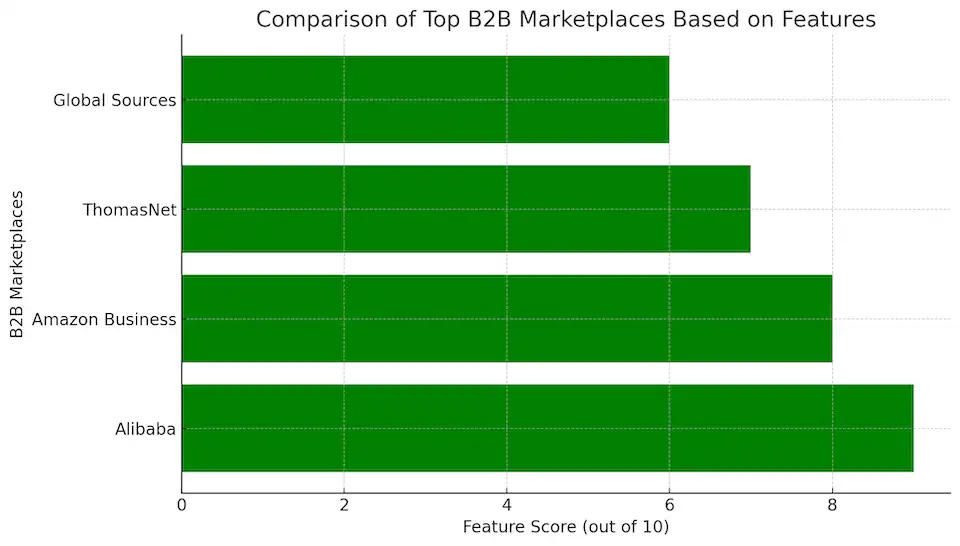
How to Choose the Right B2B Marketplace for Your Business
| Factor | Considerations | Examples |
|---|---|---|
| Industry Focus | Match with your business sector (Vertical/Horizontal) | Alibaba, ThomasNet |
| Scalability | Ability to expand and handle increased operations | Amazon Business |
| Pricing Models | Compare costs (Commission, Subscription, Hybrid) | Alibaba (commission), Amazon Business (subscription) |
| Value-Added Services | Logistics, verification, and analytics | Faire (managed marketplace) |
Choosing the right B2B marketplace is crucial for businesses looking to optimize their procurement processes and expand their reach. Here are key factors to consider:
- Industry Focus:
- Identify whether a platform specializes in your industry (vertical) or offers a broad range of products across industries (horizontal). Platforms like ThomasNet are ideal for industrial needs, while Alibaba serves multiple sectors globally.
- Scalability and Integration Capabilities:
- Evaluate the platform’s ability to scale with your business growth. Look for features like API integration, ERP/CRM compatibility, and support for expanding product catalogs.
- User Experience:
- A user-friendly interface, responsive customer support, and easy navigation are critical. Platforms with enhanced search functions and personalized dashboards (like Amazon Business) can save time and increase efficiency.
- Pricing Models:
- Compare commission-based, subscription-based, or hybrid models. Determine which aligns with your budget and transactional volume. For example, commission-based models might be cost-effective for smaller businesses, while subscriptions offer stability for larger enterprises.
- Value-Added Services:
- Look for additional services such as logistics support, payment solutions, and supplier verification. Managed marketplaces like Faire offer these services to simplify business operations and build trust.
By carefully considering these factors, businesses can select the most suitable B2B marketplace that aligns with their industry needs, growth goals, and operational strategies.
Step-by-Step Guide for Businesses Entering a B2B Marketplace
For businesses looking to enter or optimize their presence on a B2B marketplace, following these steps can ensure a successful start:
- Research and Select the Right Platform:
- Evaluate different marketplaces based on industry focus, pricing models, and integration capabilities. Choose the one that aligns with your business needs and growth goals.
- Create a Comprehensive Business Profile:
- Set up your company profile, including product listings, certifications, and relevant business information. Ensure your profile is professional and detailed to build trust with potential buyers.
- Optimize Product Listings:
- Use high-quality images, detailed descriptions, and accurate specifications. Incorporate relevant keywords to improve visibility in marketplace searches.
- Leverage Analytics Tools:
- Many B2B marketplaces provide analytics features to track visitor behavior, product performance, and market trends. Use these insights to refine your offerings and marketing strategies.
- Engage with Potential Buyers:
- Be proactive in responding to inquiries, negotiating terms, and building relationships with other businesses. Offering personalized deals or discounts can enhance engagement and loyalty.
- Monitor and Adapt:
- Regularly review your marketplace performance. Adapt strategies based on sales data, customer feedback, and industry trends to stay competitive.
By following these steps, businesses can effectively establish and grow their presence on B2B marketplaces, maximizing their reach and sales potential.
Top Examples of B2B Marketplaces in 2024
In 2024, several B2B marketplaces stand out due to their industry focus, technological innovations, and global reach. Here are the top examples:
- Alibaba:
- A leading global B2B platform, Alibaba connects millions of suppliers and buyers worldwide. It offers a wide range of products across multiple industries, making it ideal for diverse business needs.
- Amazon Business:
- Specializing in various industries, Amazon Business integrates logistics, payment solutions, and analytics, providing a comprehensive digital procurement solution for companies of all sizes.
- ThomasNet:
- Focused on the industrial and manufacturing sectors, ThomasNet offers verified suppliers and customized solutions for businesses needing specialized equipment and materials.
- Global Sources:
- This marketplace excels in international trade, especially for electronics, hardware, and textiles, connecting suppliers primarily from Asia with global buyers.
According to Forbes, these examples demonstrate the diversity and capabilities of B2B marketplaces, each catering to different business needs and offering unique features to enhance business operations.
Case Studies or Success Stories
To illustrate the effectiveness of B2B marketplaces, let’s explore real-world examples where businesses have successfully leveraged these platforms:
- Alibaba – Scaling a Global Supply Chain:
- A mid-sized manufacturing company used Alibaba to expand its reach internationally. By optimizing their product listings and utilizing Alibaba’s logistics solutions, they grew their exports by 150% in two years.
- ThomasNet – Industrial Supplier Growth:
- An industrial supplier specializing in machinery parts used ThomasNet’s industry-specific tools to target buyers more effectively. The platform’s verification process increased trust, resulting in a 40% increase in long-term contracts.
- Amazon Business – Streamlining Procurement:
- A tech startup streamlined its procurement through Amazon Business, reducing costs by 30% using bulk purchasing and advanced analytics to track inventory needs.
These case studies highlight the transformative power of B2B marketplaces and provide insights into strategic approaches businesses can adopt for growth and scalability.
Regulatory and Compliance Considerations
As B2B marketplaces continue to expand globally, they must navigate an increasingly complex regulatory landscape. Understanding and adhering to these regulations is crucial for businesses operating on these platforms, as non-compliance can lead to legal issues, fines, and reputational damage. Here are the key regulatory and compliance considerations businesses need to be aware of when using B2B marketplaces:
1. Data Privacy Regulations
- GDPR (General Data Protection Regulation): For businesses operating within or transacting with the European Union, GDPR compliance is essential. This regulation mandates how companies collect, store, and manage personal data, ensuring user privacy and data security.
- CCPA (California Consumer Privacy Act): Companies dealing with Californian businesses or consumers must adhere to CCPA regulations, which provide similar data protection measures as GDPR, focusing on consumer rights and data handling transparency.
- Other Regional Regulations: Depending on the region, businesses must comply with local privacy laws such as China’s PIPL (Personal Information Protection Law) and Brazil’s LGPD (Lei Geral de Proteção de Dados).
Ensuring compliance involves setting up robust data protection measures, obtaining user consent for data collection, and providing users with the option to access or delete their data.
2. Trade Compliance and Cross-Border Regulations
- Tariffs and Duties: For international transactions, businesses must be aware of tariffs and duties imposed by various countries. Accurate classification of products and proper documentation are necessary to avoid penalties and ensure smooth cross-border trade.
- Export Control Regulations: Countries like the United States enforce strict export control laws that prohibit or regulate the export of specific products, services, or technologies to certain countries or entities. Businesses need to understand these regulations to ensure their products are compliant.
- Sanctions Compliance: Platforms and businesses must adhere to international sanctions lists, such as those maintained by the UN or the Office of Foreign Assets Control (OFAC). Transactions with blacklisted entities can lead to severe penalties and reputational damage.
B2B marketplaces often offer compliance tools that help businesses verify trade requirements and sanctions, ensuring that transactions adhere to international laws.
3. Tax Compliance
- Value-Added Tax (VAT): For businesses operating in regions like the European Union, compliance with VAT regulations is mandatory. Companies must accurately collect, report, and remit VAT on transactions, especially for cross-border sales.
- Sales Tax Compliance: In the United States, varying sales tax regulations across states require businesses to manage different tax rates and filing requirements. B2B marketplaces often integrate tax management solutions to automate these processes and ensure compliance.
- Customs Duties: Businesses importing or exporting goods through B2B platforms must be aware of customs duties and their impact on product pricing and overall costs. Proper customs documentation is critical to avoiding delays and fines.
Implementing automated tax compliance software or using marketplace-provided tax services can help businesses efficiently manage these complexities.
4. Product and Industry-Specific Compliance
- Product Safety Standards: Certain products, such as electronics, food items, and pharmaceuticals, must meet specific safety and quality standards before they can be traded internationally. Compliance with these standards is crucial for gaining market access and avoiding legal issues.
- Certifications and Labels: Many industries require certifications (e.g., ISO, CE marking) or labels (e.g., organic certification for food) to verify that products meet regulatory and quality standards. Businesses must ensure that their products adhere to these requirements before listing them on B2B marketplaces.
- Environmental and Sustainability Compliance: Increasingly, businesses are required to meet environmental regulations, such as the RoHS (Restriction of Hazardous Substances) directive or compliance with sustainability standards like FSC (Forest Stewardship Council) certification for wood products.
B2B marketplaces often provide product verification services and access to compliance experts to help businesses navigate these specific requirements.
5. Anti-Money Laundering (AML) and Know Your Customer (KYC)
- B2B marketplaces are increasingly adopting AML and KYC practices to prevent financial crimes and ensure secure transactions. Businesses operating on these platforms may need to provide verified information about their operations, including business licenses, ownership details, and financial records.
- These compliance measures help build trust within the marketplace ecosystem and reduce the risk of fraudulent activities, protecting both buyers and sellers.
6. Digital Payment Compliance
- PCI-DSS Compliance (Payment Card Industry Data Security Standard): B2B platforms that handle online payments must comply with PCI-DSS to protect customer payment information. This involves implementing encryption protocols, secure payment gateways, and regular security audits.
- Cross-Border Payment Regulations: Businesses dealing with international payments must comply with regulations like FATCA (Foreign Account Tax Compliance Act) in the U.S. or PSD2 (Revised Payment Services Directive) in the EU. These regulations ensure the legal movement of funds across borders, prevent fraud, and secure digital transactions.
Ensuring compliance with these digital payment standards is critical for businesses to build trust and maintain a secure payment infrastructure.
Navigating regulatory and compliance requirements is essential for businesses leveraging B2B marketplaces. By understanding and implementing necessary measures like data privacy protection, trade compliance, tax management, and product standards, companies can operate effectively while minimizing risks. Utilizing marketplace-provided compliance tools or consulting with legal experts can further streamline adherence, ensuring that businesses maximize their success on B2B platforms while maintaining full compliance with international and local regulations.
The Future of B2B Marketplaces
As we move into 2024, several trends and technologies are shaping the future of B2B marketplaces:
- AI and Automation:
- AI-driven solutions are enhancing product recommendations, optimizing pricing strategies, and automating procurement processes, leading to faster and more accurate transactions.
- Blockchain Integration:
- Blockchain technology is being integrated into B2B platforms to increase transparency and security. It provides tamper-proof records for transactions, enhancing trust between parties.
- Sustainability Focus:
- With rising consumer and regulatory demands for sustainability, B2B marketplaces are increasingly focusing on eco-friendly practices and offering carbon-neutral shipping options.
- Niche Marketplaces:
- The growth of niche and specialized B2B platforms continues, catering to specific sectors like renewable energy, healthcare equipment, and sustainable materials. These marketplaces offer tailored solutions, fostering closer business relationships.
- Seamless Digital Ecosystems:
- The evolution of B2B platforms into comprehensive digital ecosystems is becoming prominent. These ecosystems integrate everything from logistics and payment solutions to analytics and CRM tools, providing a one-stop shop for businesses.
The future of B2B marketplaces is promising, with technology driving efficiency, transparency, and specialization. Businesses that adapt to these trends can gain a competitive advantage, leveraging these platforms to optimize their operations and expand their market reach.
Tips for Maximizing Success on B2B Marketplaces
To thrive on B2B marketplaces, businesses need a strategic approach that maximizes their visibility, builds trust, and ensures operational efficiency. Here are some key tips to help businesses optimize their presence and success on these platforms:
1. Optimize Product Listings for Search Visibility
- Use Relevant Keywords: Ensure your product titles and descriptions include industry-specific keywords that buyers commonly search for. This improves the likelihood of appearing in search results within the marketplace.
- High-Quality Images and Videos: Visual content significantly impacts buyer decision-making. Use high-resolution images and detailed product videos to showcase product features, quality, and functionality.
- Detailed Product Descriptions: Provide comprehensive details, including dimensions, materials, specifications, and usage instructions. This helps buyers make informed decisions and reduces the need for further inquiries.
2. Leverage Analytics and Market Insights
- Analyze Buyer Behavior: Utilize marketplace analytics to track buyer behavior, including the most viewed products, average time spent on listings, and conversion rates. This data can inform which products to prioritize or optimize further.
- Identify Trends: Monitor market trends and buyer demands to adapt your offerings and marketing strategies accordingly. By staying ahead of trends, you can capitalize on high-demand products and outpace competitors.
- Adjust Pricing Strategically: Use data insights to implement dynamic pricing strategies that match market conditions and competitor prices, ensuring you remain competitive without compromising margins.
3. Build Strong Relationships with Buyers
- Engage Promptly and Professionally: Respond quickly to inquiries and provide professional communication throughout the buying process. A strong buyer-seller relationship builds trust and encourages repeat business.
- Offer Customized Deals: Where possible, offer personalized deals, bulk discounts, or flexible payment terms to long-term or high-volume buyers. Tailoring offers to individual buyer needs enhances loyalty and encourages larger transactions.
- Follow-Up for Feedback: Request feedback after transactions and use it to improve your service and product offerings. Positive reviews and high ratings boost your credibility and visibility on the platform.
4. Utilize Marketplace Advertising and Promotion Tools
- Paid Ads and Product Boosting: Many B2B platforms offer advertising services to promote products. Investing in paid ads or product-boosting features can increase visibility and drive traffic to your listings.
- Feature in Promotions or Highlighted Sections: Participate in platform-specific promotions or request placement in highlighted sections for greater exposure. Platforms often offer seasonal promotions that help boost visibility during peak buying periods.
5. Ensure Compliance and Certification for Credibility
- Obtain Relevant Certifications: Certifications such as ISO, CE marking, or industry-specific approvals increase buyer trust and enhance your marketplace presence. Highlight these certifications prominently in your profile and product listings.
- Adhere to Platform Guidelines: Follow the marketplace’s rules and regulations closely to maintain a positive seller rating. Complying with delivery timelines, product quality standards, and communication protocols is essential to avoid penalties or account suspension.
- Highlight Sustainability Practices: With the rising focus on sustainable and ethical business practices, showcasing your adherence to environmental standards (e.g., carbon-neutral shipping) can appeal to eco-conscious buyers and differentiate your brand.
6. Automate and Streamline Business Operations
- Integrate with ERP and CRM Systems: Seamlessly integrate your existing systems with the B2B marketplace using APIs for real-time inventory management, order processing, and customer relationship management. This ensures accurate data flow and reduces manual errors.
- Automate Inventory and Order Management: Utilize marketplace tools that automate inventory updates and order tracking to keep buyers informed about stock levels and delivery timelines. Automated systems improve efficiency and customer satisfaction.
- Use Payment Automation Solutions: Implement automated invoicing and payment processing tools to ensure timely transactions, reducing the risk of payment delays and improving cash flow management.
7. Focus on Building a Strong Brand Presence
- Create a Professional and Complete Profile: A complete business profile, including logos, certifications, client testimonials, and a company overview, helps build credibility and trust among buyers.
- Share Success Stories and Case Studies: Highlight your expertise and reliability through case studies or success stories. Showcasing previous work and satisfied clients enhances your reputation and demonstrates your ability to meet buyer needs effectively.
- Engage in Content Marketing: If the marketplace allows, publish articles, guides, or videos related to your industry or products. Content marketing builds authority and attracts more visitors to your profile and listings.
Maximizing success on B2B marketplaces requires a proactive and data-driven approach. By optimizing product listings, leveraging marketplace tools, and building strong buyer relationships, businesses can significantly enhance their presence and performance. Ensuring compliance, automating operations, and focusing on brand building further strengthens a company’s position, enabling sustained growth and success in the competitive landscape of B2B platforms.
Conclusion
B2B marketplaces have become a critical component of the modern digital economy, providing businesses with efficient, scalable, and transparent procurement solutions. By understanding how these platforms work, evaluating their features, and leveraging the right marketplace for their needs, businesses can enhance their operations, reduce costs, and expand their global reach.
As technology continues to evolve, embracing the latest trends like AI, blockchain, and niche specialization will be essential for businesses to stay competitive. Adapting to these changes ensures that companies not only thrive but also lead in the ever-growing B2B marketplace landscape.
Looking to build a powerful B2B marketplace tailored to your business needs? Miracuves offers cutting-edge solutions that integrate the latest technologies like AI, blockchain, and analytics. Whether you’re scaling your operations, optimizing procurement, or expanding globally, our expert team provides tailored support and seamless implementation. Ready to take your business to the next level?
Contact Miracuves today for a consultation and transform your B2B marketplace vision into reality!
Thinking of launching your own marketplace?
Discover how leading platforms thrive using commission-based, subscription, or hybrid models. Let us help you design a scalable and profitable marketplace strategy.
FAQs
1. What is a B2B marketplace?
A B2B marketplace is an online platform where businesses can buy and sell products or services directly with other businesses. It streamlines procurement processes, offering transparency, scalability, and access to global markets.
2. How do B2B marketplaces work?
B2B marketplaces connect buyers and suppliers through a digital platform, facilitating transactions with tools for search, secure payments, logistics, and data analytics to optimize business operations.
3. What are the benefits of using a B2B marketplace?
Benefits include cost savings, global access, streamlined procurement, enhanced transparency, data-driven decision-making, and scalability to support business growth.
4. What are the top B2B marketplaces in 2024?
Leading platforms include Alibaba, Amazon Business, ThomasNet, and Global Sources, each offering unique features tailored to different industries and business needs.
5. How can I choose the right B2B marketplace for my business?
Consider factors like industry focus, scalability, pricing models, and value-added services such as logistics and analytics support to find the best fit for your needs.
6. What challenges do B2B marketplaces face?
Common challenges include trust issues, scalability, compliance with regulations, and integration complexities. Modern platforms use technologies like AI and blockchain to address these issues.
Explore our E-commerce solutions offered by Miracuves – designed for reach, reliability, and business growth:
Alibaba Like Product – A powerful B2B marketplace solution for connecting global buyers and sellers with smooth transactions and scalable features like product.
Amazon Like Product – A feature-rich e-commerce solution for multi-vendor management, seamless shopping experience, and secure payments like product.
Noon Like Product – A trusted service offering an easy-to-use platform for shopping, with a wide selection of products across various categories.
Aliexpress Like Product – An e-commerce service providing affordable products directly from suppliers, ideal for global shoppers seeking variety.
Flipkart Like Product – A reliable online shopping service offering a variety of products with excellent customer support and delivery options.
Related Articles:



